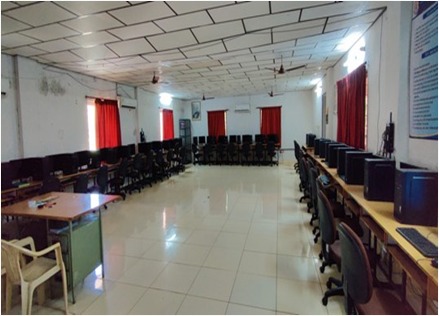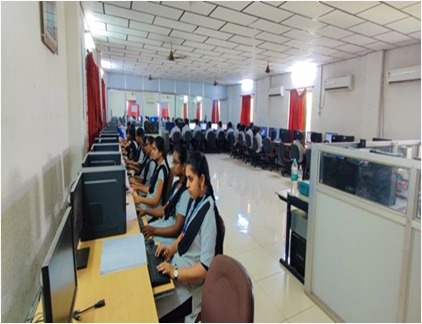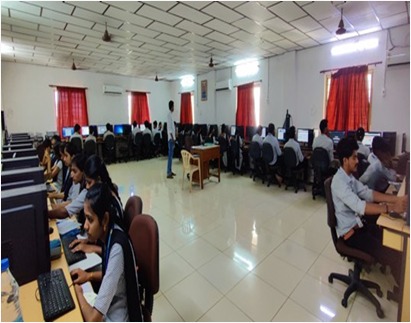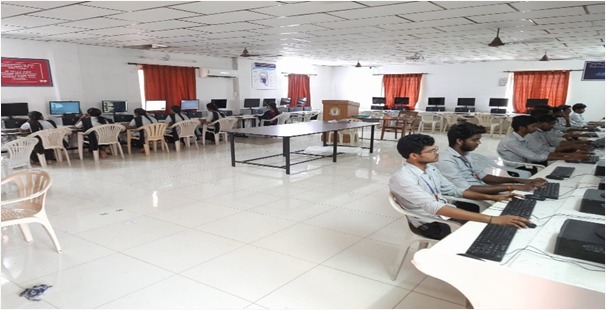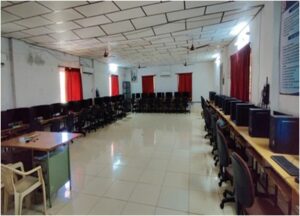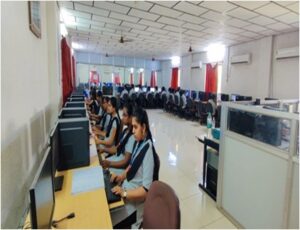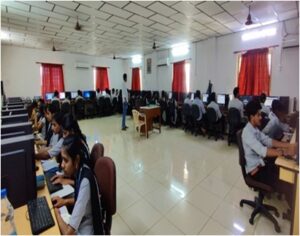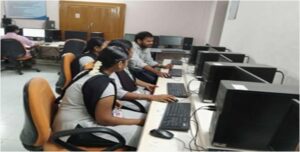| S.No | Name of the Laboratory | Number of Systems | Name of the Important Equipments | Total Lab Area |
| 1 | CSE Lab 1 | 35 | I3 3rd Generation/DDR4 4 GB RAM/500 HDD/18.5″ inch LED Monitor/TVse Champ Keyboard/DELL Mouse /Windows 7 | 84.54Sq.Mts. |
| 2 | CSE Lab 2 | 31 | I3 3rd Generation/DDR4 4 GB RAM/256 SSD/18.5″ inch LED Monitor/Acer Keyboard/Acer Mouse /Windows 7 | 84.54Sq.Mts. |
| 4 | I3 10th Generation/DDR4 8 GB RAM/256 GB SSD/19.5″ TFT Acer Monitor/Acer Keyboard/Acer Mouse/Windows 10 | |||
| 3 | CSE Lab 3 | 31 | I3 3rd Generation/DDR4 4 GB RAM/256 SSD/18.5″ inch LED Monitor/Lenovo Keyboard/Lenovo Mouse/Windows 7 | 84.54 Sq.Mts |
| 4 | I3 10th Generation/DDR4 8 GB RAM/256 SSD/18.5″ inch LED Monitor/Lenovo Keyboard/Lenovo Mouse/Windows 10 | |||
| 4 | Project Lab | 32 | I3 10th Generation/DDR4 8 GB RAM/256 GB SSD/19.5″ TFT Acer Monitor/Acer Keyboard/Acer Mouse/Windows 10 | 84.54 Sq.Mts |
| 5 | Research Lab | 33 | I3 10th Generation/DDR4 8 GB RAM/256 GB SSD/19.5″ TFT Lenovo Monitor/Lenovo Keyboard/Lenovo Mouse/Windows 10 |
Physical lab In – charge | Mr. G V SRIRAM
|
Technical Staff(Programmer) | Mrs. L RAMA DEVI
|
No. of Systems | 35
|
Configuration | Core i3 3rd Gen Processor, 4 GB RAM, 500 GB HDD, 18.5 Monitor.
|
Description:
The purpose of CSELab-I is to introduce to students to the field of programming using Java Programming language. Java is a widely used object-oriented programming language and software platform that runs on billions of devices, including notebook computers, mobile devices, gaming consoles, medical devices and many others. The rules and syntax of Java are based on the C and C++ languages. One major advantage of developing software with Java is its portability. Once you have written code for a Java program on a notebook computer, it is very easy to move the code to a mobile device. When the language was invented in 1991 by James Gosling of Sun Microsystems (later acquired by Oracle), the primary goal was to be able to “write once, run anywhere. After Completion of the course student should able to Use the syntax and semantics of java programming language and basic concepts of OOP, Develop reusable programs using the concepts of inheritance, polymorphism, interfaces and packages, Apply the concepts of Multithreading and Exception handling to develop efficient and error free codes, Design event driven GUI and web related applications which mimic the real word scenarios.
Physical lab In – charge | Mr K V CHANDRAN
|
Technical Staff(Programmer) | Mr G BALAJI
|
No. of Systems | 35
|
Configuration | Core i3 10th Gen Processor,8 GB RAM, 256 GB SSD, Acer 18.5 Monitor.
|
Description :
In this lab, we are going to cover what databases are, why you should use a database how to interact with them. We will ask students to use basic DDL, DML,DCL AND TCL COMMANDS. then students will be creating a small database from a dataset that we provide, and then practice queries on a much larger database that we will also provide. The aim of Software Engineering Virtual Lab is to impart state-of-the-art knowledge on Software Engineering and UML to users in an interactive manner through the Web. this lab includes Identifying the requirement from problem statements, Estimation of project metrics, Modeling UML usecase diagram & capturing use case scenarios, E-R modeling from the problem statements, Identifying domain classes from the problem statements, Activity & state chart modeling, Modeling UML class diagram & collaboration diagrams/sequence diagrams, Modeling DFD, Estimation of test coverage metrics & structural complexity, Designing test suite.
AI Tools & Techniques, OS, SE, DBMS, WT,
Physical lab In – charge | Mr K S H PRASANNA KUMAR |
Technical Staff(Programmer) | Mrs K VAISHNAVI |
No. of Systems | 35
|
Configuration | Intel Core i3-10th Gen, M70C 8 GB RAM and 256 GB SSD ,18.5’’ LED Lenovo Monitors.
|
Description:
We will train students to Know the components and structure of mobile application development frameworks for Android and windows OS based mobiles. Understand how to work with various mobile application development frameworks. Learn the basic and important design concepts and issues of development of mobile applications. Understand the capabilities and limitations of mobile devices. Apply essential Android Programming concepts. Develop various Android applications related to layouts & rich uses interactive interfaces. Develop Android applications related to mobile related server-less database like SQLITE.
OOPS through C++ Lab, OS Lab, R-Programming Lab, SOC, WT Lab.
Physical lab In – charge | Mrs P L RAJA RAJESWARI |
Technical Staff(Programmer) | Mrs M R SOWJANYA |
No. of Systems | 32 |
Configuration | Core i3 10th Gen Processor,8 GB RAM, 256 GB SSD, Acer 18.5 Monitor
|
Description:
In this lab students will be able to understand the technical challenges posed by current mobile devices and wireless communications, be able to evaluate and select appropriate solutions. . Appreciate the need to keep up with rapid changes and new developments, be able to identify current trends in mobile communications technologies and systems. Select and evaluate suitable software tools and APIs for the development of a particular mobile application and understand their strengths, scope and limitations. Use an appropriate application development to design, write and test small interactive programs for mobile devices. AI, R-Programming, Project.
